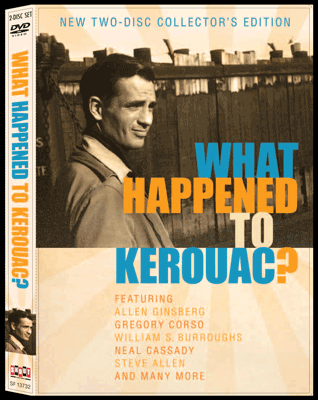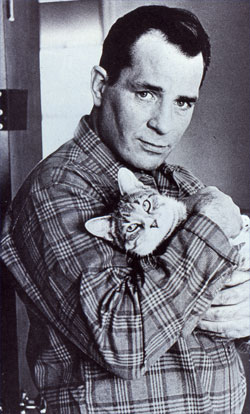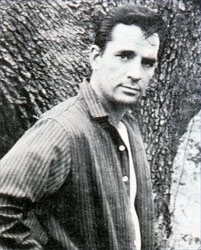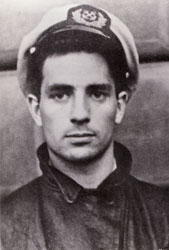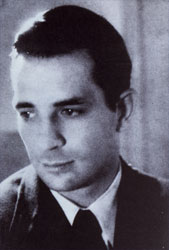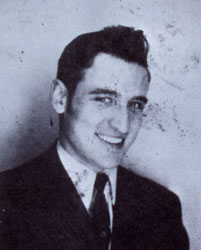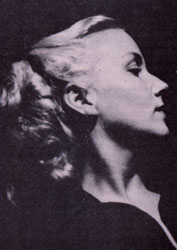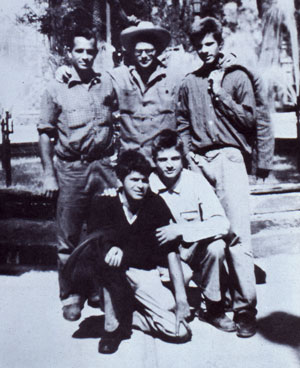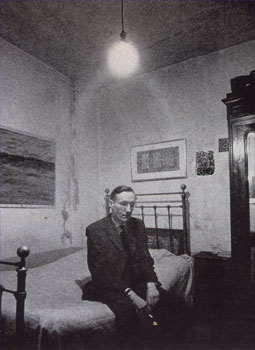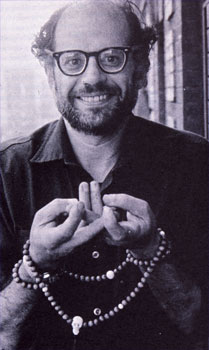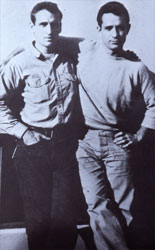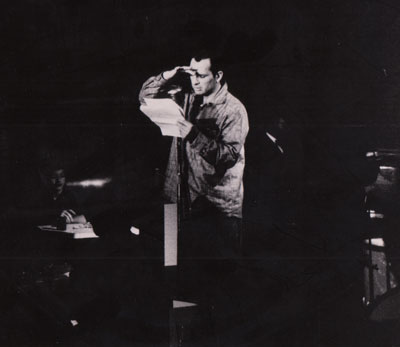U.S. release of the new 2-disc collector's edition from Shout Factory at:
 
"A must see for anyone interested in The Beat Movement, Shout! Factory’s release of
WHAT HAPPENED TO KEROUAC? has literally hours of fascinating footage from the
prime movers of this volatile era. Recommended!" --Fox 31 Denver more...
with 17 bonus extras... includes The Beat Goes On, 2 hours and 19 minutes of rare and unseen extras -
17 chapters with Abbie Hoffman, Timothy Leary, Paul Krassner, Allen Ginsberg, William S. Burroughs,
Gregory Corso, Gary Snyder, Steve Allen, Ann Charters, Michael McClure, Robert Creeley, Herbert Huncke,
Carolyn Cassady, Paul Gleason, John Clellon Holmes, Edie Kerouac Parker,
Jan Kerouac, William Buckley, and Father Spike Morissette.
|
"What Happened to Kerouac? certainly belongs in the top echelon of movies about the Beats, principally because Lerner
and MacAdams got to all the right people. Fellow writers Burroughs, Corso, Ginsberg, Lawrence Ferlinghetti,
Michael McClure, and John Clellon Holmes speak candidly and incisively about Kerouac and his work."
J.R. Jones, Chicago Reader, Video Drone more...
"For anyone interested in Kerouac or the Beat movement, this set is a goldmine of interesting anecdotes,
history and footage from the people who lived it."
Angelique Flores, Home Media Magazine more...
"A treasure for any fans of the Beat movement or Kerouac in particular... "
Judge Gordon Sullivan, DVD Verdict more...
It's comprehensiveness and clean construction make it a must-see for anyone interested in documentary filmmaking.
Comprised of archival interviews, slurred television appearances... the narrative circles from the booze-soaked,
puffy-faced end of Kerouac’s life back to his glorious late nights in Times Square. It’s ideal for both novices and adepts.
Violet Lucca, FilmComment.com more... |
| |
"Tender but never maudlin, respectful but never solemn, this is exemplary
biographical filmmaking."
Edward Guthmann, San Francisco Chronicle more...
"...magnificently illuminates Kerouac's persona as a pop star..."
Boston Globe
"A sad, funny, irreverent film about the most famous and controversial of the 'beat generation' writers."
The Christian Science Monitor
"...a film that will fascinate writers, as well as anyone interested in the politics of celebrity and the practice of alternative lifestyles. That adds up to an audience of just about everybody."
Barry Spacks, Santa Barbara News-Press |
|
FEATURING:
Allen Ginsberg
Gregory Corso,
William Burroughs
Steve Allen
William F. Buckley
Charlie Parker
Neal Cassady
Lawrence Ferlinghetti
Gary Snyder
and others |
|
|
|
|
FEATURING:
Jack Kerouac on William Buckley's "Firing Line" (1968)
Jack Kerouac on "The Steve Allen Show" (1959) .
Neal Cassady and Allen Ginsberg in City Lights Book Store (1965)
Charlie Parker, Winner of the Downbeat Award (1951)
Times Square Footage, Rudy Burckhardt (late1940s)
Directed by Richard Lerner & Lewis MacAdams
Producer - Richard Lerner
Interviewer - Lewis MacAdams
Co-Producers - Lewis MacAdams, Nathaniel Dorsky, Malcolm Hart
Editors - Nathaniel Dorsky, Robert Estrin
FESTIVAL SCREENINGS
World Premiere-San Francisco International Film Festival
Denver Film Festival
New Directors/New Films New York, Film Society of
Lincoln Center, New York
Torino Film Festival
Rotterdam Film Festival
Montreal Film Festival
|
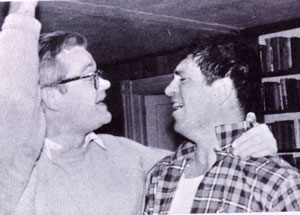
|
"Anyone who's a fan of Kerouac, or who would like to know about him, will be thrilled to see so much great stuff packed into one film...Everything one can hope for in a documentary!
Zen Bones, imdb
"Any TV station worth it's name should have snapped up this documentary ages ago."
Colin Shearman, Q13 London more... |
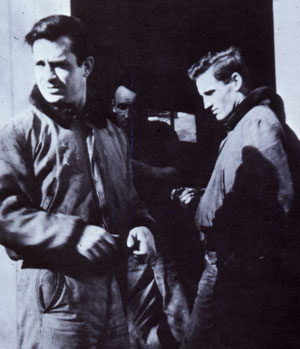
|
|
|
| |
|
|
|
|
| |
|
|
|
Making of What Happened to Kerouac ?
|
|
What Happened to Kerouac? was conceived when Lewis MacAdams and I attended a weeklong conference in 1982 at Colorado’s Naropa Institute, celebrating the 25th anniversary of the publication of Kerouac’s seminal work, On the Road. We spent the week taping twenty-one hours of interviews with Kerouac’s cronies and ex-lovers from the Beat movement. Everyone from Allen Ginsberg, Gregory Corso, and William Burroughs to Kerouac’s daughter, Jan, and his first wife, Edie Kerouac Parker, contributed memories and anecdotes made remarkably vivid by the convergence at this event of the many people who knew Jack Kerouac.
These interviews would become the backbone for the film. Yet for two years following the conference nothing happened with the footage. The project fell into limbo due to lack of money. It was wasteful and ridiculous to do nothing. I had filmed the Colorado interviews and knew how good the footage was. Then I raised some money and recruited my longtime friend Nick Dorsky, also a Kerouac fan and filmmaker, to edit the film.
Even when I was a junior in high school in Queens, New York, in 1959, my friends and I were flipped-out by On the Roadand The Dharma Bums. Nick grew up in New Jersey and at fifteen had read On the Road. “That book broke my heart in a way,” he remembers. “It was like all of a sudden someone just poked me right in the chest.” |
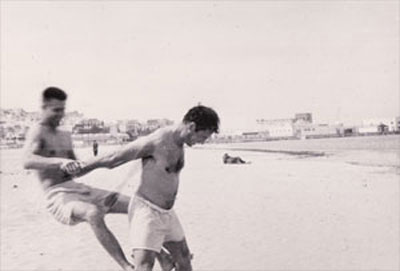 |
In making the film we were trying to show some of these great people before they disappeared. We had a rule to only use people from the interviews that knew Kerouac personally. Gregory Corso became a main voice in the film, providing humor and a poet’s insight. He had a lot to say, debunking a lot of the myths. But we couldn’t lose track of Kerouac’s voice ever during the film. We found we couldn’t go more than several minutes without having Jack in there speaking.
We didn’t want to depict Kerouac as an historical object in the film. It was very important to hear Jack’s voice and to treat it as poetry that is always alive. We found several recordings of Kerouac reading from his work—including Desolation Angels,Visions of Cody,andhis ode to Charlie Parker and his chorus to his mother in Mexico City Blues. We wove these throughout the film. |
Kerouac’s genius is most evident in his reading of Dr. Sax taken from a rare audiotape and in his reading of “October in the Railroad Earth” from Lonesome Traveler and “Friday Afternoon in the Universe” from Old Angel Midnight. In order to provide a visual complement to these recordings Nick shot 16mm Kodachrome footage in San Francisco, where Kerouac spent a great deal of time in the ’50s, and in Lowell, Massachusetts, where Kerouac was born and reared. Nick thought it was a precarious thing putting images to someone’s words, especially since the language is so successful. “You don’t want to overpower the words. The images could be literal or contrapuntal.”
Another visual highlight is the colorful footage from Rudy Burckhardt’s 1940s Times Square movies illustrating the big city’s nighttime world, inhabited here, by Allen Ginsberg and Herbert Huncke. Also, we incorporated two sharply contrasting stages of Kerouac’s life reflected in footage from two TV interviews. One with a nervous, shy Kerouac reading Visions of Cody on the Steve Allen Show in 1959, and the other, a drunk, witty, and ornery Kerouac on William F. Buckley’s Firing Line in 1968. To add more depth to the narrative I went out with cameraman Pat Darrin and shot interviews with Kerouac’s biographer Ann Charters, and the priest from his youth, Father Armand “Spike” Morissette.
|
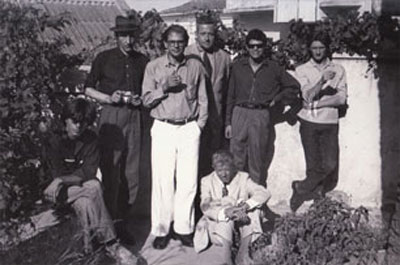 |
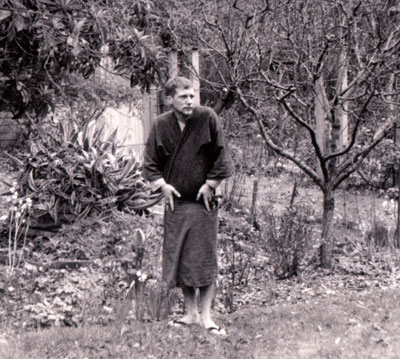 |
The film has always been appealing to several generations. The three of us, Nick, Lewis, and myself, were in our forties when we made it. We felt the film was not only for people our age, it was also for people in their teens and twenties. The rampart materialism that existed in the 1950s when Kerouac was writing was parallel to what was going on in the 1980s, and is even more extreme today. Perhaps younger people are interested in seeing how these themes were dealt with in another time.
For an independent documentary in the 1980s, What Happened to Kerouac? played for a wide audience. New Yorker films released it theatrically in the U.S. and it played at many international festivals, including San Francisco, Denver, Montreal, Rotterdam, Torino, and New Directors/New Films at the Museum of Modern Art in New York City.
|
For this new DVD I re-mastered the original film, which included color correction, adding new photos,
and a jazz score by the talented pianist Austin Peralta.
In looking over some of the many film reviews from the 1980s, I was struck by a line that mirrored our own thinking. The film couldn’t answer its own title question in a way that is easily put into words. Michael Sragow wrote in the San Francisco Examiner: “That they don’t offer a definitive answer to What Happened to Kerouac? is true to the man himself who like Walt Whitman (one of his heroes) contained multitudes.”
|
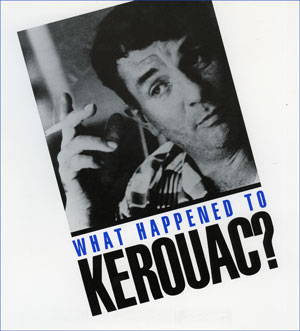 |
|
|
| |
More information on Jack Kerouac at Wikipedia
 |
|
|
|


![]()
![]()
